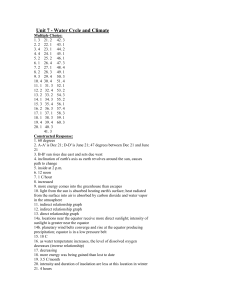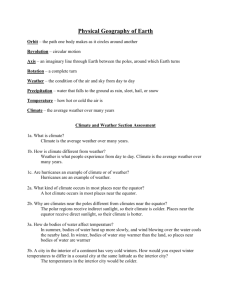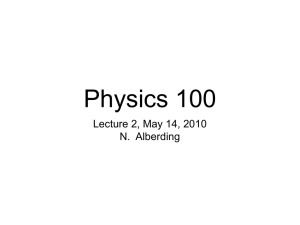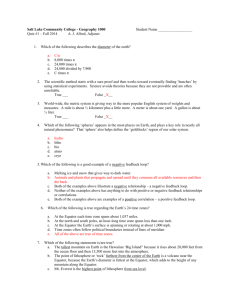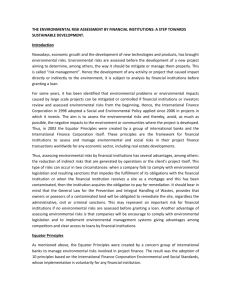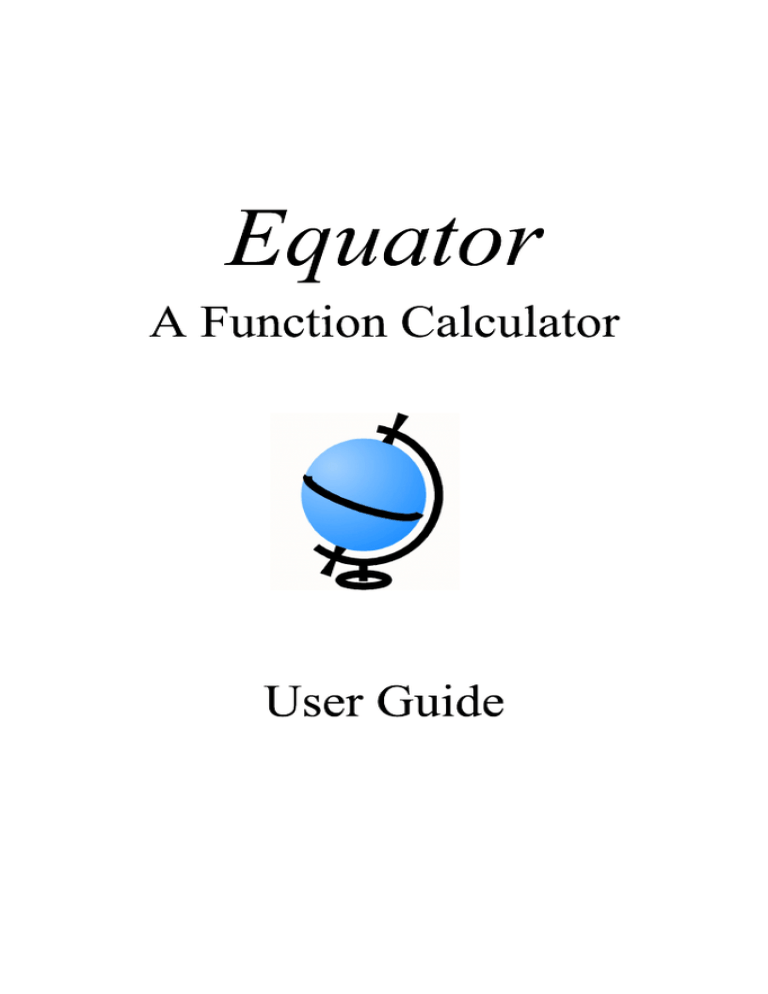
Keith B. Oldham
Trent University
Peterborough, Ontario, Canada
Jan C. Myland
Trent University
Peterborough, Ontario, Canada
Jerome Spanier
University of California
Irvine, California, U.S.A.
Springer
New York Berlin Heidelberg London Paris Tokyo
Copyright © 2008 K.B. Oldham, J.C. Myland and J. Spanier. All
rights reserved. Printed in U.S.A.
About Equator
1
Getting started
2
Operating Equator
4
Equator functions and keywords
22
Legalities
37
Envoi
38
Equator
The Equator software was conceived as an integral part of the
book An Atlas of Functions*, though its utility is not limited to users
of the book. The Atlas is available in both print and electronic
formats and full details can be found at www.springer.com. Equator
is offered for sale as a stand-alone unit in part to benefit those whose
access to the Atlas is through a portal to the electronic version.
Equator is a software package designed to generate numerical
values of over 200 mathematical functions used by engineers,
scientists and others. Among the functions made available by
Equator are such simple ones as cosines and binomial coefficients
as well as more elaborate examples such as Bessel functions and
elliptic integrals. Consult the table at the back of this booklet for a
comprehensive listing of the functions to which Equator caters,
together with the corresponding keywords recognized by Equator.
In addition to its primary goal of providing function values,
Equator will perform a number of subsidiary tasks.
The notation in Equator is identical to that in An Atlas of
Functions. The algorithms used by Equator are not published, but
the formulas on which they are based are identified in the Atlas.
Equator is easy to use and its operation will soon become as
intuitive as using your hand calculator. We hope that you will find
it useful.
*
Keith B. Oldham, Jan C. Myland and Jerome Spanier, An Atlas of Functions,
Second Edition, Springer, New York, 2008.
1
Equator must be installed from the CD onto the hard drive of a
personal computer running at least Windows XP. The present
version is not designed to operate on Macintosh computers or on
Unix/Linux systems.
You may need “administrator privileges” in order to install
Equator, A Function Calculator.
Memory and processor
requirements adequate for running Windows XP will satisfy
Equator's needs. During its installation, Equator will check if
Microsoft’s .Net Framework 2.0 is already installed on your
computer. If not, Equator will automatically download and install
.Net Framework 2.0 for you.
The following simple steps will enable you to install Equator:
! Insert the CD into your computer’s disk drive. If the installation
program does not immediately start, the “autorun” feature may be
disabled on your computer. If so, double-click the CD drive icon
under My Computer; then double-click the setup.exe file.
! If it is absent from your computer, you will be asked to install .Net
Framework 2.0 and you will need to be connected to the internet to
do so. Click Accept when the .Net license agreement appears. The
required files will be downloaded and installed. This may take
several minutes.
! An Application Install - Security Warning screen may appear. Just
click the Install button.
! Follow the prompts to complete the installation of Equator. You
will be required to accept a licensing agreement.
! A shortcut to Equator will have been placed in the Start menu and
2
an Equator icon will have appeared on your desktop.
! The first time you run Equator you will be prompted to input your
name, address, and licensing code. The code will be found with the
CD that you purchased.
Should you ever need to uninstall Equator, double-click Add or
Remove Programs on the Windows Control Panel. Select Equator
from the list and click Remove.
3
Equator
Double-click the Equator icon
on your desktop. If your
computer monitor is not set to 1024 × 768, you will see the
following screen
You may, or may not, wish to adjust the resolution. Click the small
Q checkbox to avoid being reminded of this next time.
Every function calculable by Equator has a name and a
keyword [see the table at the back of this booklet for a complete
list]. Equator’s opening screen,
invites you to type either the name or the keyword into the header
box. Alternatively, you may scroll down through the comprehensive
alphabetized list to locate the sought name or keyword, then select
and click it. The experienced user will use the typing option and will
type the keyword, once familiar with it. As you type, Equator will
try to anticipate your choice and will also display the corresponding
mathematical symbol. For example, if wanting a binomial
coefficient you type the keyword “bincoef”, the screen will show:
4
Once the sought function’s name or keyword appears, click the
button. In the binomial coefficient example, this brings up
the following starting screen:
Because the binomial coefficient is bivariate, there are two input
boxes but, depending on the function, there can be as many as four
or as few as zero input boxes. For now, ignore the small square
checkboxes. Recognize that you are being asked to type numbers
into the
and
boxes.
You might, for example, enter “17.5” and “13” for these variables.
Then, on clicking the
button, you will find that Equator
responds immediately with the answer screen:
5
At any time prior to clicking
, you can return to the start screen
by pressing the Esc key.
With the calculation complete, there are now three buttons that
you might click. One of these allows you to proceed to calculate the
value of a different binomial coefficient. Another permits the choice
of a new function. The third exits Equator.
The basics of Equator have now been covered, but there are
several additional optional features.
Memories and constants
Notice the “ #” message following the answer in the screenshot
above. This indicates that the answer has been stored by Equator in
6
a #-memory, in case you might need to use it in some subsequent
“chain” calculation. If, to continue with the previous example, you
wished to find the logarithm of the binomial coefficient 17.5
, you
13
need only summon the logarithm routine and type “#” into the
argument box. Clicking
then generates the logarithm of the
binomial coefficient.
The #-memory is ephemeral. Numbers so stored are retained
only until the next time
is clicked. Sometimes, however, you
may want to use a calculated answer more than once. To preserve
an answer, type ctrl-M. This stores the answer into a more permanent
M-memory. To reuse it, simply type “M” or “m” wherever the
stored value is needed. It will remain stored until you overwrite it,
or end the Equator session.
The values of seven mathematical constants and many of the
most widely used physical constants are encoded in Equator. See
the section on Data input on page 14.
Variable construction
Knowing the value of some input quantity t, one often needs to
find the value, not of the function f(t) of t itself, but of some
modified variable, such as f(t) or f(1+ t 2). Equator caters to this
need by providing a facility to construct a desired input variable in
accordance with the formula
x wt p k
The default values of the multiplier w, power p, and the constant k
are 1, 1, and 0, but these parameters may be altered by the user.
For example, you might want to compute log2(3). Click
and then choose the function logarithm to any base (or
the keyword loganybase), which computes log(x). Enter 2 into the
7
box. Next click the checkbox
and also,
to signify that it is argument x that is being constructed rather than
the base , click the " button to the left of
.
The screen now appears as:
Enter “3” into the t box and “pi” into the p box, leaving k and w
with their default values. Then, on clicking
, the screen appears
as:
8
Notice that, as well as the answer being generated, the calculated
value of the argument x is shown, “grayed out” in the appropriate
variable box.
No more than one variable may be constructed in this way.
Variable ranging
You might wish to determine, not just a single value of, say, a
binomial coefficient, but a whole range of values. Equator provides
for this need with its “variable ranging” feature. Test this out by
again choosing the binomial coefficient function (keyword bincoef)
and then clicking the checkbox
. The screen
appears. Notice that the " button opposite the first variable, v, is
already selected, on the assumption that it is this variable, rather than
m, that you wish to range. If this is not your wish, click the button
opposite m, converting it from
to
and allowing you to insert
values into the appropriate boxes.
Equator will always evaluate the function at the value of the
variable shown in the “to” box, even if this value is not in the chosen
9
sequence. For example, if you ask for output from 1 to 10 in steps
of 2, you will be given f(1), f(3), f(5), f(9) and f(10) values.
If you choose v 17.5 and decide to range m from 1 to 17 in
steps of 2 then, after clicking
, the screen will be
You can combine the construction and ranging features of
Equator by ranging on any one of the w, t, p, or k construction tools.
Simply click both Q checkboxes and the " button alongside
whichever one of the tools you choose to range. Imagine, for
example, that you wish to find the cosine of several submultiples of
; perhaps cos(/2), cos(/3), cos(/4), , cos(/8). The next
screenshot shows how this may be accomplished and what the
answers are.
10
You cannot construct one variable and range another.
Other uses of ranging
Equator has no plotting capability, but should you wish to graph
the output of a ranged calculation, you can easily transfer the data to
graphing software, such as Excel or SigmaPlot ®. Equator’s Edit
menu provides a Copy results to clipboard facility which is useful for
data transfer, not only for graphing, but also for creating hard copy
or for another purpose.
Every time you use the ranging feature, Equator maintains a
running sum of all the values it enters into the rightmost data
column. Normally no use is made of this sequential addition and the
user is unaware of its occurrence. However, if you wish to see the
11
sum, type ctrl-S and the sum will appear as an additional final entry
in the rightmost column. This sum is simply
sum = f(x1 ) f( x2 ) f( x3 ) f( xN )
where x1 is the first argument, and f(xN) is the last. This facility can
be used, for instance, as a means of summing certain finite series.
Alternatively, if you type ctrl-A, the average, sum/N, appears.
Likewise, Equator automatically compiles another kind of sum
each time a ranging calculation is performed. The sum in this case
is called the trapezoidal area and it is
trapezoidal
h 12 f( x1 ) f( x2 ) f( x3 ) 12 f( xN 1 )
area
xN xN 1
f( xN 1 ) f( xN )
2
where h is the increment. To access this value, type ctrl-T. The
trapezoidal area is output at the bottom of the rightmost column. It
provides an approximation to the definite integral
xN
f(t )dt
x1
trapezoidal
area
How good this approximation is depends on the properties of the
function, as well as on N, the number of data you have specified.
These three facilities are inoperative if the ranged data consists
of more than one column, or if any of the data are unavailable or out
of range. The value of the sum, average or trapezoidal area is
computed by unsophisticated summation; no steps are taken to
ensure that all reported digits are significant.
12
Data input
You may enter a numerical value into Equator as an integer or
a decimal number in either fixed or floating point (scientific)
notation. Thus 765, 0.00573, and 12.987E78 are all acceptable
inputs, but not E78 without a preceding number. E may be
replaced by e, but not by 10. The minus sign, , must precede a
negative input, but + is optional for a positive number. Up to 15
digits may be input; any extra will be ignored. With decimal
notation, Equator assumes that all digits beyond those input are
zeros; thus 17.666 is treated as 17.666 00000 00000. The magnitude
of input numbers may range between E308 and E307.
As alternatives to numbers, the following “number substitutes”
may be input:
! the # symbol, representing the value last calculated by Equator.
If the calculation involved ranging, it is the result of the final
calculation that is stored in #.
! the M or m symbol, representing a number previously placed in
the M-memory.
! any one of the first seven keywords listed in the table overleaf,
representing a mathematical constant.
! any one of the twenty keywords listed in the lower section of the
table, representing a fundamental physical constant, a conversion
factor or an accepted standard. For the most part, these constants are
known to less than 15-digit precision, but Equator takes no
cognizance of this limited precision in calculations involving these
constants.
! fractions, such as 17/369 or pi/8.4E7. The format must be two
numbers (or number substitutes) separated by a solidus, “/”. Equator
converts the fraction to a decimal number before utilizing it in
13
calculations, but it does remember that a fraction was input, because
this is important in some computations.
Symbol and name
Keyword
Value
, Archimedes’s constant
pi
3.1415 92653 58979
G, Catalan’s constant
catalan
0.91596 55941 77219
e, base of natural
logarithms
ebase
2.7182 81828 45905
, Euler’s constant
euler
0.57721 56649 01533
g, Gauss’s constant
gauss
0.83462 68416 74073
Z, Apéry’s constant
apery
1.2020 56903 15959
, golden section
golden
1.6180 33988 74990
c, velocity of light / m s1
lightc
299 792 458
h, Planck’s constant / J s
Planckh
6.6260 690 E34
k, Boltzmann’s constant
/ J K1
Boltzmannk
1.3806 504 E23
L, Avogadro’s constant
/ mol1
AvogadroL
6.0221 418 E23
F, Faraday’s constant
/ C mol1
FaradayF
9.6485 340 E4
R, gas constant
/ J K1 mol1
gasR
8.3144 72
0, permittivity of space
/ F m1
epsilon0
8.8541 87817 62039 E12
14
Symbol and name
Keyword
Value
0, permeability of space
/ N A2
mu0
1.2566 37061 43592 E6
qe, electron charge / C
electronq
1.6021 76487 E19
me, electron mass / kg
electronm
9.1093 8215 E31
mp, proton mass / kg
protonm
1.6726 2164 E27
mn, neutron mass / kg
neutronm
1.6749 27201 E27
G, gravitational constant
/ N m2 kg2
gravityG
6.67428 E011
R, Rydberg constant / m1 RydbergR
1.0973 73156 8527 E7
, fine structure constant
alpha
7.2973 52537 6 E3
u, atomic mass unit / kg
amu
1.6605 38782 E27
Da, dalton / kg
amu
1.6605 38782 E27
eV, electron volt / J
eV
1.6021 76487 E19
g, standard gravitational
acceleration / m s2
earthg
9.8066 5
Tstd, standard laboratory
temperature / K
standardT
298.15
Pstd, standard atmospheric
pressure / Pa
standardP
101 325
Equator makes no general provision for the input of complex or
imaginary numbers, but the complex number raised to a real power,
the square-root function, and the exponential function of complex
15
argument routines do accept real and/or imaginary input.
Equator uses the period as the decimal separator. This is the
standard in many geographical regions. If, however, you are
working in a country where the comma customarily fills the
separator role, then (unless that setting in your computer has been
changed), you must use a comma when inputting decimal numbers
and Equator will respond in that system. Otherwise, Equator will
use the period as the decimal separator and you should too. If you
use commas for any purpose, when the decimal separator is the
period, they are ignored. Conversely, periods will be ignored
whenever the decimal separator is the comma. For visual
convenience, you may wish to insert spaces within a number; that’s
okay: Equator will ignore them.
Data Output
Answers that are integers smaller in magnitude than 1E16 are
reported as integers. Function values whose magnitudes lie in the
range 0.1 to 1000 are output in fixed-point decimal format.
Otherwise a standard floating point notation, exemplified by
1.2345 67890 12345E+123
is adopted. Equator can rarely output nonzero numbers outside the
ranges 1E308 to 1E307 and 1E308 to 1E307.
A few of Equator’s routines (the power function, cubic zeros,
etc.) provide dual outputs: the real and imaginary parts of the
complex answer. Some other routines (for example, the zeros, and
associated values, of the Bessel functions) provide two real answers.
In these cases, it is the penultimate output (often the real part) that is
retained in the #-memory.
16
Equator strives to generate answers with “15-digit precision”,
by which we mean 14 exact digits, with the fifteenth having some
uncertainty. This is not always possible. Generally, however,
Equator is able to detect when precision is likely to have been lost
during its calculations and it then curtails the output, such that all the
reported digits (of which there may be as few as 3) are significant;
that is, only the final reported digit is ever uncertain. If, for any
reason, you wish to know what the original 15-digit answer was, just
type “#”: the uncurtailed answer will usually be displayed.
If Equator cannot confidently provide a function value, even
one with only three significant digits, it will report “unavailable” or
give some explanation of its failure.
Other Equator features
As do many computer programs, Equator allows mouse-less
operation. Thus, instead of clicking on the
button, you can
type alt-C. Likewise, you may navigate between the various input
boxes by use of the keyboard Tab key. The
or
buttons
may be similarly replaced by the Enter key.
Equator allows you to input arguments to the trigonometric and
Gudermannian functions in radians (the default) or degree measure.
Simply click the appropriate " button. Likewise you have the choice
of radian or degree output from the inverse trigonometric and inverse
Gudermannian functions and the elliptic amplitude routines.
The rational approximation routine (keyword rational) provides
a means of approximating a decimal number by a quotient of two
integers. Thus it finds the numerator and denominator in such
relationships as
17
355
113
The nearest binary approximant routine (keyword bin) as described
on page 21, is another approximation feature of Equator.
Equator usually gives an answer almost immediately. Rarely,
however, the operation may be slow. The
message at the top of the screen will confirm that calculation is
proceeding. If you wish to abort a computation, press the Esc key.
Arithmetic processing
So that you will have little need to supplement your Equator
calculations by using a regular calculator, Equator has routines that
carry out simple arithmetic operations. Routines for addition,
subtraction, multiplication, division, square root and exponentiation
exist and have the keywords +, , *, /, sqrt, and power. As well,
the construction feature may be used for these purposes. However,
Equator has another powerful tool to supplement function
computation.
The “construction” feature, described earlier, is a valuable way
of tailoring your data prior to using them in evaluating the function
of interest. There is often a requirement to tailor Equator’s output
similarly, to suit your particular need. For example, you might have
just calculated arctan(2x/), when what you actually need is
x arctan 2 x / . To aid in such a supplementary task,
Equator provides an arithmetic function (keyword arith). This is a
quadrivariate function defined by
arith(W , T , P, K ) WT P K
where each of W, T, P, and K may be any number or number
18
substitute. To use the arithmetic function in the example cited, one
may choose the four parameters as follows
arith(#, x, 1 2 , pi) x arctan 2 x /
However the arithmetic function is more powerful than that
example suggests because any one of the four parameters may itself
be constructed, opening the possibility of using as many as seven
parameters in formulating the output. Any one of those seven may
be ranged in the normal way.
Though the arithmetic function is used most often as a sequel to
a prior calculation (via the # or M memories), that is not its only
application. For instance the quantity (x + 1)/2x may be calculated
as arith(pi/2,1,1,0.5/x), or in other ways. It may also be used to
construct more elaborate input variables than the unaided
“construction feature” can handle. As you become familiar with
Equator, you will find the arithmetic function invaluable.
Accuracy
A whole book could be, and perhaps one day will be, written
about the measures that Equator adopts to preserve accuracy in
calculating function values. Here we merely mention three sources
of inaccuracy and methods by which some of these hazards may be
mitigated. First note that there are two ways in which inaccuracies
may be characterized. One is in terms of the absolute error
ˆ x) f( x)
absolute error f(
where f(x) is the true value of the function at the argument x and
f̂( x ) is the calculated value. The second is the relative error
ˆ x) f( x ) f(
ˆ x) f( x )
relative f(
ˆ x)
error
f( x)
f(
19
A “good” algorithm is one that generates a small absolute error.
However, it is the latter measure, the relative error, that determines
how many digits can legitimately be reported as a function value. To
report 15 digits requires that the relative error be on the order of
1E15. It is the relative error that is usually thought of as reflecting
“how accurate” an answer is.
Unless some special procedure can be exploited, there is
inevitably a large inaccuracy associated with computing the value
of a function at an argument close to one of its zeros. The truth of
that statement is clear on inspection of previous equation. Whenever
x is close to a zero of the function, the denominator will be very
small, which places extremely severe demands on the accuracy of
computation of f̂( x ) if the relative error is to be acceptably small. Of
course, you may not even know that your input variable(s)
correspond to a function value close to a zero. A small numerical
value of the answer will provide a clue that this is the case and
explain why Equator returns an answer with severely curtailed
precision. An “inadequate significance” message may be returned
if your argument is extremely close to a zero.
A second issue relates to number systems. Like most computer
programs, Equator operates with binary numbers. On the other
hand, the user inputs a decimal number. Hence, an early step in the
operation of Equator is the conversion of the user’s decimal number
into a binary number. Now, some decimal numbers, such as
73.244 16503 90625, are also exact binary numbers (in this example
1010110.110000000001), whereas another decimal number, such as
73.244 39024 39025, which is superficially similar, is not. The first
number converts exactly to a binary number, whereas the second
number will be converted by Equator into the nearest binary
number. This obligatory approximation that Equator makes may or
20
may not engender a serious error in the output. It depends on how
“steep” the function is at the argument in question; that is, the
inaccuracy depends on the magnitude of f /x. Sometimes this
derivative can be very large indeed (especially close to a
discontinuity). If the input variable is not an exactly binary number,
inevitable inaccuracies may be present in the output, especially if the
function is steep. These inaccuracies will arise, of course, even if
Equator returns an exact answer – it is the exact answer for a
different argument. If you suspect that your answers may risk
contamination from this cause, and if your particular problem allows,
it will generally help if you use only inputs that are exactly binary.
For this purpose, Equator has a nearest binary approximant routine
(keyword bin), described in Section 8:14. This algorithm outputs,
in decimal, the nearest exactly binary number, of no more than 15
decimal digits, to the input number. Of course, an alternative is to
restrict yourself to input numbers, such as 73, 73.75, or 73.03125,
that you recognize on sight as exactly binary.
Precision is lost whenever two numbers of like sign are
subtracted, and Equator takes cognizance of this loss by outputting
only digits that are significant. Numerous such subtractions are
especially destructive of precision and hence there is the danger of
severe loss of precision whenever a computation incorporates the
modulo operation, or its special case, extraction of the fractionalpart, as a necessary part of the routine. A case in point that arises
frequently is the calculation of such functions as sin(x) when x is
large. To evade this problem, Equator provides a reperiodized sine
function routine and a reperiodized cosine function (keywords sinpi
and cospi) that internally multiply the x by and provide accurate
sin(x) and cos(x) values, no matter how large x might be.
21
Equator
In addition to recognizing the full names of functions and
sometimes their synonyms, Equator recognizes the following
keywords, which are sequences of up to ten characters,
mnemonically mirroring either the symbol or the name of the
function. There follows a comprehensive listing of all Equator’s
routines and the corresponding keywords. The final column lists the
relevant chapter (or appendix) of the book, An Atlas of Functions,
and often the section too. Please refer to that book (see the footnote
on page 1) for further information on the various functions.
Name and symbol
Keyword
Chap or
Section
addition, +
+
C:10
Airy Ai function, Ai(x)
Ai
56
Airy Bi function, Bi(x)
Bi
56
Apery’s constant, Z
apery
1:7
Archimedes’s constant,
pi
1:7
arithmetic function, arith(W,T, P, K)
arith
C:10
associated Laguerre polynomial,
L(nm ) ( x )
assocLpoly
23:12
associated Legendre function of the
first kind, Pv( m ) ( x )
assocP
59:12
associated Legendre function of the
second kind, Q (vm ) ( x )
assocQ
59:12
22
Keyword
Chap or
Section
associated value of extremum of
Bessel function, J jn( k )
extremeJ
52:7
atomic mass unit, u
amu
A:3
auxiliary Airy fai function, fai(x)
fai
56:6
auxiliary Airy gai function, gai(x)
gai
56:6
auxiliary cosine integral, gi(x)
gi
38:13
auxiliary cylinder fc function, fcv(x)
fc
54:14
auxiliary cylinder gc function, gcv(x)
gc
54:14
auxiliary Fresnel cosine integral,
Fres(x)
Fres
39:13
auxiliary Fresnel sine integral, Gres(x) Gres
39:13
auxiliary sine integral, fi(x)
38:13
Name and symbol
fi
Avogadro’s (Löschmidt’s) constant, L AvogadroL
A:5
base of natural logarithms, e
ebase
1:7
Bateman G function, G(v)
G
44:13
Bateman’s confluent function, v(x)
kappa
48:13
Bernoulli number, Bn
Bnum
4
Bernoulli polynomial, Bn(x)
Bpoly
19
Bessel function, Jn(x) or Jv(x)
J
52 or 53
(complete) beta function, B(v,)
Beta
43:13
beta number, (v)
betanum
3
23
Name and symbol
Keyword
Chap or
Section
binomial coefficient, ( mv )
bincoef
6
bivariate eta function, (v,u)
eta
64:13
Boltzmann’s constant, k
Boltzmannk
A:5
catalan
1:7
Catalan’s constant, G
Chebyshev gamma coefficient,
(n)
j
Chebygamma 22:5
Chebyshev polynomial of the first
kind, Tn(x)
Tpoly
22
Chebyshev polynomial of the second
kind, Un(x)
Upoly
22
Chebyshev tau coefficient, (kn )
Chebytau
22:6
Clausen’s integral, Clausen(x)
Clausen
32:14
common mean, mc(x,y)
mc
61:14
complete beta function, B(v,)
Beta
43:13
complete elliptic integral of the first
kind, K(k)
EllipticK
61
complete elliptic integral of the second
EllipticE
kind, E(k)
61
complete elliptic integral of the third
kind, (v,k)
EllipticPi
61:12
complete gamma function, (v)
Gamma
43
complex number raised to a real
power, (x + iy)n or (x + iy)v
compower
10:11 or
12:8
24
Name and symbol
Keyword
Chap or
Section
cosecant function, csc(x)
csc
33
cosine function, cos(x)
cos
32
cosine integral, Ci(x)
Ci
38
cotangent function, cot(x)
cot
34
cotangent root, n(b)
rho
34:7
cubic function, x 3 +ax 2 +bx c
cubic
16
cubic zeros, r3(a,b,c,n)
r3
16:7
cumulative function for a Boltzmann
distribution, FBoltzmann(,x)
FBoltzmann
27:14
cumulative function for a Laplace
distribution, FLaplace(,,x)
FLaplace
27:14
cumulative function for a logistic
distribution, Flogistic(,,x)
Flogistic
27:14
cumulative function for a lognormal
distribution, Flognormal(,,x)
Flognormal
27:14
cumulative function for a Lorentz
distribution, FLorentz(,,x)
FLorentz
27:14
cumulative function for a Maxwell
distribution, FMaxwell(,x)
FMaxwell
27:14
cumulative function for a normal
distribution, Fnormal(,,x)
Fnormal
27:14
cumulative function for a Rayleigh
distribution, FRayleigh(,x)
FRayleigh
27:14
25
Name and symbol
Keyword
Chap or
Section
Dawson’s integral, daw(x)
daw
42
Debye
3:15
decadic logarithm, log10(x)
log10
25:14
digamma function, (v)
digamma
44
dilogarithm, diln(x)
diln
25:12
discrete Chebyshev polynomial,
t (nJ ) ( x )
discCheby
22:13
division, ÷
/
C:10
double factorial function, n!!
!!
2:13
electron charge, qe
electronq
A:5
electron mass, me
electronm
A:5
electron volt, eV
eV
A:3
elliptic amplitude, am(k,x)
am
63
elliptic nome, q(k)
q
61:15
entire cosine integral, Cin(x)
Cin
38
entire exponential integral, Ein(x)
Ein
37
entire hyperbolic cosine integral,
Chin(x)
Chin
38
entire incomplete gamma function,
n(v,x)
gamentire
45
x
Debye function,
0
26
t n dt
exp(t ) 1
Name and symbol
Keyword
Chap or
Section
error function, erf(x)
erf
40
error function complement, erfc(x)
erfc
40
eta number, (v)
etanum
3
Euler number, En
Enum
5
Euler polynomial, En(x)
Epoly
20
Euler’s constant,
euler
1:7
exponential error function complement
experfc
product, exp x erfc x
41
exponential function, exp(x)
exp
26
exponential function of complex
argument, exp(x+iy)
complexp
26:11
exponential integral, Ei(x)
Ei
37
exponential polynomial, e(x)
epoly
26:12
exponential theta-four function,
4 (v, t )
theta4
27:13
exponential theta-one function,
1 (v, t )
theta1
27:13
exponential theta-three function,
3 ( v , t )
theta3
27:13
exponential theta-two function,
2 (v, t )
theta2
27:13
27
Name and symbol
Keyword
Chap or
Section
extrema, and their (associated) values,
of the Bessel function,
Jextrema
jn ( k ) and J( jn( k ) )
52:7
factorial function, n!
!
2
Faraday’s constant, F
FaradayF
A:5
Fibonacci number, Fib(n)
Fibnum
23:14
Fibonacci polynomial, Fibn(x)
Fibpoly
23:14
fine structure constant,
alpha
A:5
fractional-part function, Fp(x)
Fp
8
fractional-value function, frac(x)
frac
8
Fresnel cosine integral, C(x)
C
39
Fresnel sine integral, S(x)
S
39
(complete) gamma function, (v)
Gamma
43
gas constant, R
gasR
A:5
Gauss hypergeometric function,
F(a,b,c,x)
F
60
Gauss’s constant, g
gauss
1:7
Gegenbauer polynomial, C ( x )
Cpoly
22:12
generalized mean, m(x,y,n)
m
61:14
golden section,
golden
23:14
gravitational constant, G
gravityG
A:5
Gudermannian function, gd(x)
gd
33:15
( )
n
28
Name and symbol
Keyword
Chap or
Section
Hermite polynomial, Hn(x)
Hpoly
24
Hurwitz function, (v,u)
Hurwitz
64
hyperbolic cosecant function, csch(x)
csch
29
hyperbolic cosine function, cosh(x)
cosh
28
hyperbolic cosine integral, Chi(x)
Chi
38
hyperbolic cotangent function, coth(x) coth
30
hyperbolic secant function, sech(x)
sech
29
hyperbolic sine function, sinh(x)
sinh
28
hyperbolic sine integral, Shi(x)
Shi
38
hyperbolic tangent function, tanh(x)
tanh
30
incomplete elliptic integral of the first
kind, F(k,)
ellipF
62
incomplete elliptic integral of the
second kind, E(k,)
ellipE
62
incomplete elliptic integral of the third
ellipPi
kind, (v,k,)
62:12
incomplete beta function, B(v,,x)
incompBeta
58
integer-part function, Ip(x)
Ip
8
integer-value function, Int(x)
Int
8
inverse cosecant function, arccsc(x)
arccsc
35
inverse cosine function, arccos(x)
arccos
35
inverse cotangent function, arccot(x)
arccot
35
29
Name and symbol
Keyword
Chap or
Section
inverse error function, inverf(x)
inverf
40
inverse Gudermannian function,
invgd(x)
invgd
33:15
inverse hyperbolic cosecant function,
arcsch(x)
arcsch
31
inverse hyperbolic cosine function,
arcosh(x)
arcosh
31
inverse hyperbolic cotangent function,
arcoth
arcoth(x)
31
inverse hyperbolic secant function,
arsech(x)
arsech
31
inverse hyperbolic sine function,
arsinh(x)
arsinh
31
inverse hyperbolic tangent function,
artanh(x)
artanh
31
inverse secant function, arcsec(x)
arcsec
35
inverse sine function, arcsin(x)
arcsin
35
inverse tangent function, arctan(x)
arctan
35
Jacobipoly
22:12
Jacobian elliptic cd function, cd(k,x)
cd
63
Jacobian elliptic cn function, cn(k,x)
cn
63
Jacobian elliptic cs function, cs(k,x)
cs
63
Jacobian elliptic dc function, dc(k,x)
dc
63
( v , )
n
Jacobi polynomial, P
30
( x)
Name and symbol
Keyword
Chap or
Section
Jacobian elliptic dn function, dn(k,x)
dn
63
Jacobian elliptic ds function, ds(k,x)
ds
63
Jacobian elliptic nc function, nc(k,x)
nc
63
Jacobian elliptic nd function, nd(k,x)
nd
63
Jacobian elliptic ns function, ns(k,x)
ns
63
Jacobian elliptic sc function, sc(k,x)
sc
63
Jacobian elliptic sd function, sd(k,x)
sd
63
Jacobian elliptic sn function, sn(k,x)
sn
63
Kelvin bei function, bei(x)
bei
55
Kelvin ber function, ber(x)
ber
55
Kelvin kei function, kei(x)
kei
55
Kelvin ker function, ker(x)
ker
55
Kummer function, M(a,c,x)
M
47
Laguerre polynomial, Ln(x)
Lpoly
23
lambda number, (v)
lambdanum
3
Langevin function, coth( x ) (1/ x )
Langevin
30:14
Legendre function of the first kind,
Pv(x)
P
59
Legendre function of the second kind,
Qv(x)
Q
59
Legendre polynomial, Pn(x)
Ppoly
21
31
Name and symbol
Keyword
Chap or
Section
Lerch function, (x,v,u)
Lerch
64:12
logarithm to any base, log(x)
loganybase
25:14
logarithm to base 10 of the factorial
function, log10(n!)
log10!
2:8
logarithm to base 10 of the gamma
function, log10{(v)}
log10Gamma 43:8
logarithmic factorial function, ln(n!)
ln!
2:8
logarithmic function, ln(x)
ln
25
logarithmic gamma function, ln{(v)} lnGamma
43:8
logarithmic integral, li(x)
li
25:13
lower incomplete gamma function,
(v,x)
gamlower
45
Macdonald function, Kv(x)
K
51
Mittag-Leffler function, Ev,(x)
Mittag
45:13
modified Struve function, lv(x)
l
57
modified (hyperbolic) Bessel function,
I
In(x) or Iv(x)
49 or 50
modified spherical Bessel function,
in(x)
i
28:13
modulo function, v(mod m)
mod
8:12
multiplication, ×
*
C:10
32
Name and symbol
Keyword
Chap or
Section
n-fold integral of the error function
complement, inerfc(x)
inerfc
40:13
nearest binary approximant, bin(x)
bin
8:14
Neumann function, Yv(x)
Y
54
neutron mass, mn
neutronm
A:5
Neville’s c theta function, c ( k , x )
theta-c
61:15
Neville’s d theta function, d ( k , x )
theta-d
61:15
Neville’s n theta function, n ( k , x )
theta-n
61:15
Neville’s s theta function, s ( k , x )
theta-s
61:15
normally distributed random variates,
normal(,,J,s)
normal
40:14
parabolic cylinder function, Dv(x)
D
46
permeability of free space, m0
mu0
A:5
permittivity of free space, 0
epsilon0
A:5
Planck’s constant, h
Planckh
A:5
Pochhammer polynomial, (x)n
Poch
18
polygamma function, (v)
polygamma
44
power function, xn or xv
power
10 or 12
probability function for a Boltzmann
distribution, PBoltzmann(,x)
PBoltzmann
27:14
probability function for a Laplace
distribution, PLaplace(,,x)
PLaplace
27:14
(n)
33
Name and symbol
Keyword
Chap or
Section
probability function for a logistic
distribution, Plogistic(,,x)
Plogistic
27:14
probability function for a lognormal
distribution, Plognormal(,,x)
Plognormal
27:14
probability function for a Lorentz
distribution, PLorentz(,,x)
PLorentz
27:14
probability function for a Maxwell
distribution, PMaxwell(,x)
PMaxwell
27:14
probability function for a normal
distribution, Pnormal(,,x)
Pnormal
27:14
probability function for a Rayleigh
distribution, PRayleigh(,x)
PRayleigh
27:14
proton mass, mp
protonm
A:5
quadratic function, ax bx c
quadratic
15
quadratic zeros, r2(a,b,c,n)
r2
15:7
quartic zeros, r4(a3,a2,a1,a0)
r4
16:12
rational approximants, n/d
rational
8:13
reperiodized cosine function, cos(x)
cospi
32:8
reperiodized sine function, sin(x)
sinpi
32:8
Rydberg constant, R
RydbergR
A:5
sampling function, sinc(x)
sinc
32:13
secant function, sec(x)
sec
33
2
34
Name and symbol
Keyword
Chap or
Section
sine function, sin(x)
sin
32
sine integral, Si(x)
Si
38
spherical Bessel function, jn(x)
j
32:13
spherical Macdonald function, kn(x)
k
26:13
spherical Neumann function, yn(x)
y
32:13
square-root function, x iy
sqrt
11
standard atmospheric pressure, Pstd
standardP
A:6
standard gravitational acceleration, g
earthg
A:6
standard laboratory temperature, Tstd
standardT
A:6
standard random numbers, random(J,s) random
40:14
Stirling number of the first kind, S(nm )
Snum
18:6
Stirling number of the second kind,
(nm )
sigmanum
2:14
Struve function, hv(x)
h
57
subtraction,
C:10
tangent function, tan(x)
tan
34
tangent root, rn(b)
r
34:7
tetragamma function, (2)(v)
tetragamma
44
Tricomi function, U(a,c,x)
U
48
trigamma function, (v)
trigamma
44
trilogarithm, triln(x)
triln
25:12
(1)
35
Name and symbol
Keyword
Chap or
Section
upper incomplete gamma function,
(v,x)
gamupper
45
velocity of light, c
lightc
A:5
Whittaker M function, Mv,(x)
WhitM
48:13
Whittaker W function, Wv,(x)
WhitW
48:13
zeros, and their associated values, of
the Bessel function, j(nk ) and J( j(nk ) )
Jzero
52:7
zeta number, (v)
zetanum
3
36
By installing the Equator software, you are agreeing to be
bound by End User License Agreement which you will find on the
CD. The following is a precis of that agreement:
This software product is protected by copyright and all rights are
reserved by the authors and Springer. You are licensed to use this
software on a single computer. Copying the software to another
medium or format for use on a single computer does not violate the
U.S. Copyright Law. Copying the software for any other purpose is
a violation of the U.S. Copyright Law.
This software product is provided as is without warranty of any
kind, either express or implied, including, but not limited to, the
implied warranty of merchantability and fitness for a particular
purpose. Neither the authors, nor Springer, nor their dealers or
distributors assume any liability for any alleged or actual damages
arising from the use of or the inability to use this software. (Some
jurisdictions do not allow the exclusion of implied warranties, so the
exclusion may not apply to you.)
37
Great care has been exercised in the creation of Equator.
However, it is too much to hope that errors are absent. The authors
would appreciate your notifying them of any errors that you detect
or difficulties you may encounter. We would also welcome any
suggestions as to additional facilities that might be included in some
future edition of Equator. We can be contacted by email at:
koldham@trentu.ca, jmyland@trentu.ca, or jspanier@uci.edu.
The authors wish to express their sincere thanks to Michelle
Johnston for her sedulous assistance in creating some of the
algorithms used by Equator and for suggesting its name. We also
appreciate the help of Sten Englom. Many at Springer have
contributed greatly to the success of this project.
38

